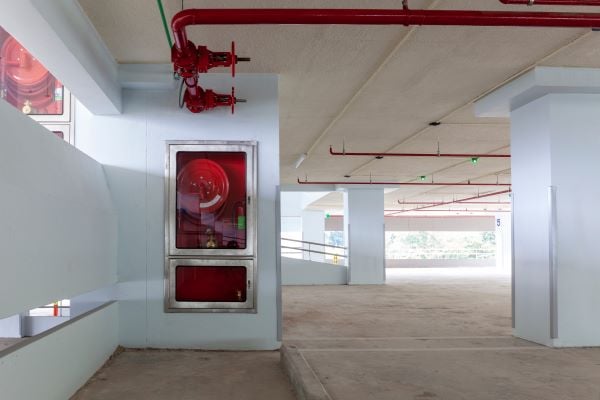
If your business uses unheated warehouses or other structures where freezing temperatures could cause the pipes in an automatic sprinkler system to burst, chances are, it is equipped with a dry-pipe fire sprinkler system. Dry-pipe sprinkler systems are used in settings where a temperature above 40°F (4°C) cannot be reliably maintained. Unlike wet-pipe systems in which the pipes are filled with water, the pipes in a dry-pipe system are pressurized with air that holds the water back from the main water line. When a sprinkler is activated, the air is released, which releases the water into the pipes where it flows to the sprinkler heads.
Download our free Fire Sprinkler Cold Weather Checklist
A common misconception regarding dry-pipe systems is that they cannot freeze because the water they require is held back by valves and only released into the pipes when the system is activated.
Dry-pipe systems can, in fact, freeze. And, when they do, they can flood the areas they are intended to protect, causing costly damage. When this happens, the system is rendered inactive. When a sprinkler system is impaired, a fire watch is required until it is repaired, which can significantly increase the expense associated with frozen pipes. This post will help you avoid this situation with some relatively simple maintenance steps you can perform on your own to help avoid a freeze-up of your dry-pipe sprinkler system.
How Can a Dry-Pipe System Freeze If It Doesn’t Hold Any Water?
This is often the first question a Koorsen technician gets when responding to a call to repair dry-pipe systems with valves and pipes broken as a result of freezing.
Water can get into a dry-pipe system in two different ways. Most often, it happens as a result of activation during routine testing or in response to a fire, which releases water into the pipes. Normally, the system would be designed with the pipes sloped to low point drains so that after an activation, any excess water can be drained from the pipes. However, if the pipes are not properly installed, the slope may not be sufficient to drain all the water left in the pipes.
Water can also collect in dry pipes as a result of condensation, which occurs when pressurizing the system with air after it has been activated. There is always some humidity in the air, which is condensed into water when the air in the pipes is pressurized. Condensation can plug a sprinkler’s valves when it freezes, preventing water from entering the pipes in the event of a fire.
In these cases, low point drains (sometimes called auxiliary drains or “drum drips”) can be installed to collect any extra water that remains after an activation and/or from condensation so it can be easily drained.
Routine Maintenance
The maintenance requirements for dry-pipe sprinkler systems can be found in the National Fire Protection Association (NFPA) 25 Standard for the Inspection, Testing, and Maintenance of Water-Based Fire Protection Systems.
While routine testing should always be completed by a factory-trained and certified technician, there are some things you can do yourself to help ensure your dry-pipe sprinkler system doesn’t freeze:
- Regularly checking all low point drains and emptying them when necessary is one of the simplest and most effective ways to avoid freeze-ups in a dry-pipe system. It only takes a few minutes to empty a low-point drain and can potentially save many thousands of dollars in repairs or replacement of your system.
- Simple visual inspections completed when checking on low-point drains can help you spot any vandalism, damage, or corrosion so it can be repaired proactively.
- Check the pressure in the pipes daily during cold weather to ensure it is sufficient to keep the valve tightly closed.
- Provide additional freeze protection for pipes in unheated areas with insulation to help block the flow of cold air from entering pipe chases and soffits, which can lead to freezing.
While all dry systems have a pressure switch that is activated when water flows, for an additional layer of protection, you can have a professional install temperature signaling devices to warn of potential freezing conditions. You can also upgrade your dry-pipe system from compressed air to nitrogen, which can eliminate condensation and corrosion from condensation.
Koorsen Fire and Security can help you with these improvements to help ensure you never have to bear the heavy expense of repairing or replacing your dry-pipe system due to a freeze-up. Freezing can be easily avoided by performing the simple steps described above and partnering with the experts at Koorsen to perform the required inspections and testing of your system. Contact Koorsen today to schedule your next inspection.
Download our free Fire Sprinkler Cold Weather Checklist
Schedule an Installation, Inspection, or Service


